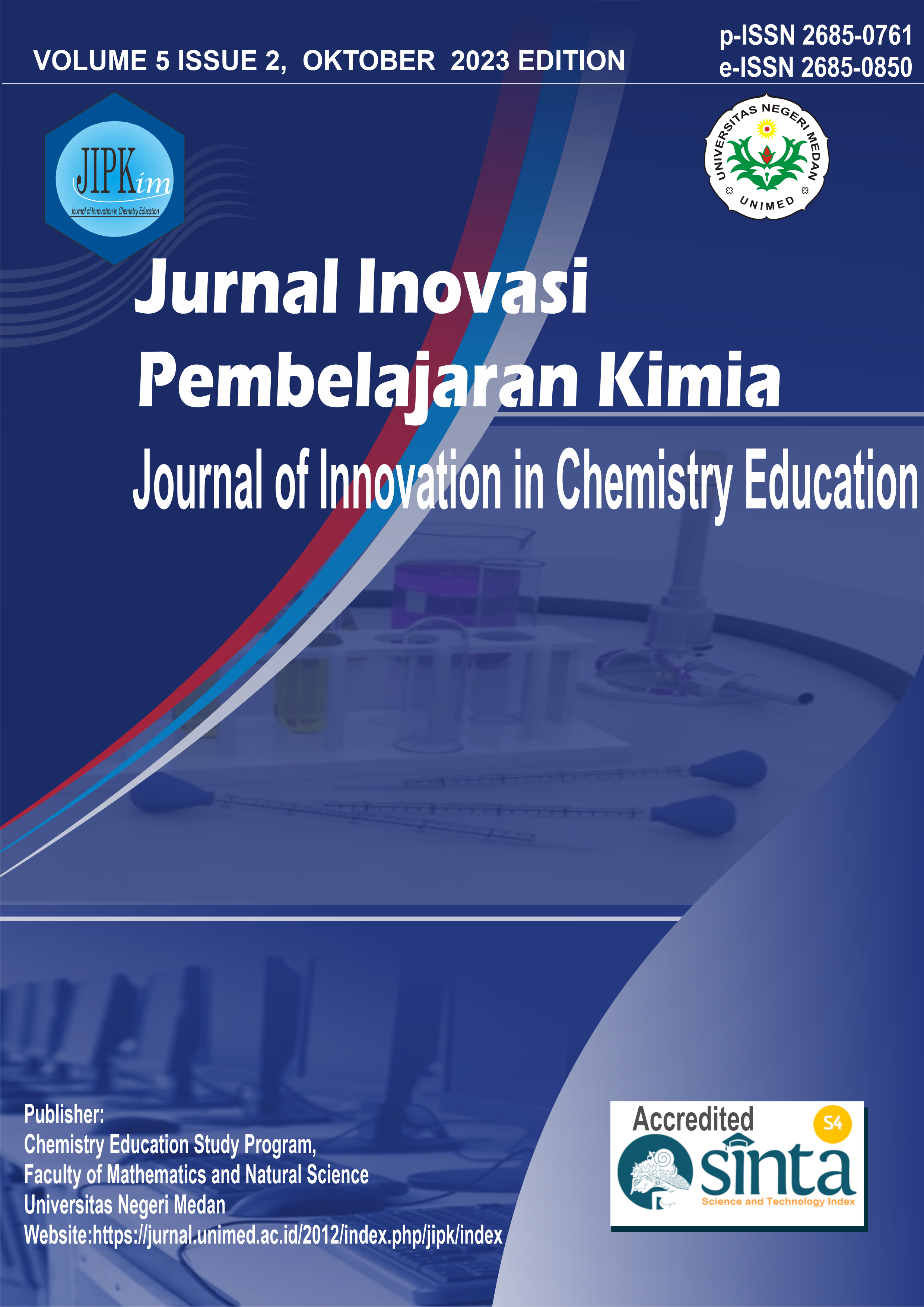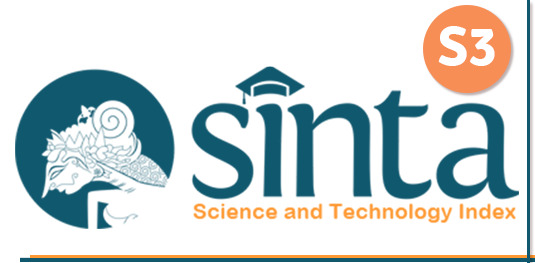The Relationship of Religiosity with Students' Critical Thinking Skills on the Subject of Stoichiometry
DOI:
https://doi.org/10.24114/jipk.v5i2.56227Abstract
Education is a learning process that is important for human life in producing quality humans. In studying science, religious science is needed to maintain balance in order to give birth to good habits in the activities of each individual. Science and religion are two things that reinforce each other. Science is present is expected to provide evidence so that it will improve the quality of one's beliefs. Similarly, the presence of religion in science can make science more useful and increase its benefit. This study aims to see the relationship between religiosity and students' critical thinking skills in class XI IPA SMA Negeri 3 Binjai. The method used is an analytical method using the Pearson correlation test. The subjects in this study were grade XI students of SMA Negeri 3 Binjai which amounted to 107 students. The instrument used was a religiosity questionnaire with 15 statements and Using critical thinking skills questions on stoichiometry material totaling 18 questions. The results of the study found that the average level of students' critical thinking skills on stoichiometric material was 29.71 and the average level of student religiosity was 42.94. The correlation coefficient between religiosity and critical thinking skills obtained is 0.809 which means that there is a strong relationship between religiosity and critical thinking skills of students in class XI IPA SMA Negeri 3 Binjai.References
Amin, M. (2020). The Relationship of Religious Motivation with Increased Learning Achievement of Students. Journal of UIN Alauddin Makassar, 9(1), 31“45.
Asmara, A. P. (2016). Study of the integration of Islamic character values with chemistry in carbon chemistry. Journal of Science Education, University of Muhammadiyah Semarang, 4(2), 1-11.
Bakar, A. (2015). The Influence of Religiosity and Study Habits on the Learning Achievement of Economic Education Students of Kanjuruhan University Malang. Proceedings of the National Seminar on Economic and Business Education, 1“10.
Dores, O. J., Wibowo, D. C., &; Susanti, S. (2020). Analysis of Students' Critical Thinking Skills in Mathematics Subjects. Journal of Mathematics Education, 2(2), 242“254.
Gioktavian, C. (2020). The Relationship Between Religiosity and Student Learning Achievement in Class XI Science Chemistry Subjects. Syarif Hidayatullah State Islamic University
Herdiansyah, H. (2016). Gender in Psychological Perspective. Jakarta: Salemba Humanika.
Holiqi, E. S., Maryani, &; Prastowo, S. H. B. (2022). Development of Contextual Assessment Instruments for Students Critical Thinking Skills Using Kahoot Quiz. Journal of Physics Education, 10(2).
Ilham, Muhammad, S.H.I., M.S.I, and Firdaus, S.H.I., M.H. Islamic Branding andReligiosity and Their Influence on Purchasing Decisions by Consumers at Al-Baik Supermarket in Tanjungpinang City. Bintan: STAIN Sultan Abdurrahman Press, 2019.
Karmawan. (2022). Religious Understanding of People and Its Relevance to Religious Pluralism in Tangerang City Society. Journal of Communication Between Islamic Universities, 21(1), 1“16.
Khasanah, B. A., &; Ayu, I. D. (2017). Students' Critical Thinking Ability through the Application of Brain Based Learning Learning Models. Exponent, 7(2), 46-53.
Marliani, R. (2016). The Relationship Between Religiosity and Learning Achievement in Students of the Faculty of Sharia and Law UIN Sunan Gunung Djati Bandung Class of 2012. Journal of Integrative Psychology, 4(2), 138“147.
Mastiah, S., Nurlaili, &; Muflihah. (2018). Analysis of Students' Critical Thinking Skills through the Advanced Organizer Learning Model on Electrolyte and Non-Electrolyte Solution Materials. Bivalent: Chemical Studies Journal, 1(2), 101“105.
Mujanah, S. (2020). Factors Influencing Critical Thinking and Its Influence on the Achievement of Untag Surabaya Students and UITM Puncak Alam Malaysia Students. Untag Consortium National Seminar, 2, 307“323.
Mulya, R., &; Sulaiman, S. (2021). The influence of religiosity values on student learning outcomes in learning Islamic religious education at SDN 10 Lubuk Alung. At-Ta'dib: Scientific Journal of Islamic Education Study Program, 171-185.
Musayaroh, T., Yuliana, I. F., &; Fatayah, F. (2021). Development of HOTS-based chemical literacy test instruments that are worthy of being reviewed from the validity of the content by experts. Unesa Journal of Chemical Education. 10(3). 243-251.
Netri, N., Holiwarni, B., &; Abdullah, A. (2018). Development of test instruments based on Higher Order Thinking Skill (HOTS) chemical equilibrium material in class XI SMA / MA. Online Journal of Students (JOM) in the Field of Teacher Training and Education. 5(2). 141-151.
Pitaloka, F. A., Supriatin, L., Azhar, N., Aini, S. Q., &; Fajrussalam, H. (2022). The influence of students' religiosity on learning achievement. Humantech: Indonesian Multidisciplinary Scientific Journal, 2(Special Issues 3), 804-814.
Prawiki, S. M., &; Helendra. (2022). Analysis of the Quality of Odd Semester Final Exam Questions for the 2020/2021 Academic Year Biology Class X Public High School 1. Journal of Biology and its Learning, 17(12), 1“12.
Purniasari, L., Masykuri, M., &; Ariani, S. R. D. (2021). Analysis of School Exam Questions for Chemistry Subjects of SMA N 1 Kutowinangun for the 2019/2020 Academic Year Using the Iteman and Rasch Models. Journal of Chemistry Education, 10(2), 205“214.
Putri, M. L. D., Hairida, H., &; Hadi, L.(2020). Description of the ability of students to solve HOTS questions on the basic laws of chemistry in high school. Journal of Equatorial Education and Learning (JPPK), 9(9).
Risdiana, A., Erna, B., &; Holiwarni, B. (2022). Development of HOTS (Higher Order Thinking Skill) questions on acid-base material for class XI high school / MA equivalent. Journal of Educational Innovation Kmia. 16(2). 111-117.
Riswanda, J. (2018). Development of Higher Order Thinking Skill (Hots) Based Questions and Their Implementation at SMA Negeri 8 Palembang. Biological Didactics: Journal of Biological Education Research, 2(1), 49-58.
Setianingsih, R., &; Roshayanti, F. (2022). Critical Thinking Skills of Students in Chemistry Learning on the Subject of Reaction Rate at SMA Negeri 1 Bantarbolang. Journal of Research in Education and Teaching, 16(1), 5“9.
Sudijono, A. (2009). Introduction to Educational Evaluation. Eagle Press.
Thorndike, R. M. (2005). Measurement and Evaluation in Psychology and Education Seventh Edition. Prentice Hall.
Warju, Ariyanto, S. R., Soeryanto, &; Trisna, R. A. (2020). Quality Analysis of HOTS Type Question Items on Student Brake System Competency in Vocational High Schools. Journal of Technology and Vocational Education, 17(1), 95“104.
Zega, I. S., &; Darmana, A. (2019). Implementation of Salt Hydrolysis Teaching Materials Integrated with Islamic Values with Problem Based Learning Models to Improve Student Learning Outcomes in terms of Student Learning Interests. Journal Of Innovation In Chemistry Education, 1(2), 64-73.













